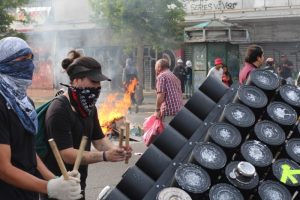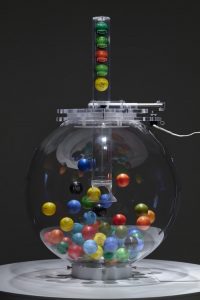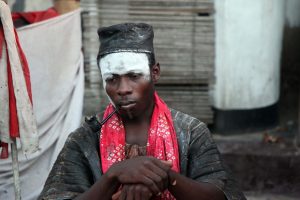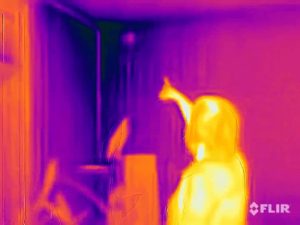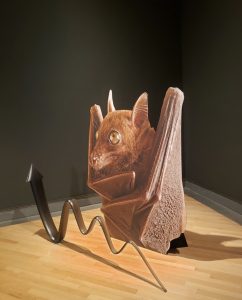A couple of weeks ago i was at the MediaLab Madrid to spy on the Interactivos? workshop. Its theme was magic and illusion which i found very witty. Now that everyone is getting their hands dirty at interactivity, it has lost some of its charm and mysteries. Interactivos? invited the participants to build software pieces and interactive installations which can propose a rethinking of the usual scenario in magic tricks, marked by a very clear separation between the wizard and the spectators. The results were very impressive and i’ll write more about it later.
 Pablo Valbuena‘s Augmented Sculpture v 1.0 was probably one of the most mesmerizing pieces. Best is to start with the video. All the video footage is recorded directly from the installation, no post-prod’ trick!
Pablo Valbuena‘s Augmented Sculpture v 1.0 was probably one of the most mesmerizing pieces. Best is to start with the video. All the video footage is recorded directly from the installation, no post-prod’ trick!
The piece investigates space-time not only as a 3D environment, but as space in transformation revealed by two layers that overlap each other:
– the physical layer, which controls the real space and shapes the volumetric base that serves as support for the next level.
– a virtual projected layer that allows to control the transformation and sequentiality of space-time.
The blending of both levels gives the impression of physical and transformable geometry. The orverlapping produces an euclidean 3D space augmented by a transformable layer that Pablo can control to alter multiple dimensions of space-time.
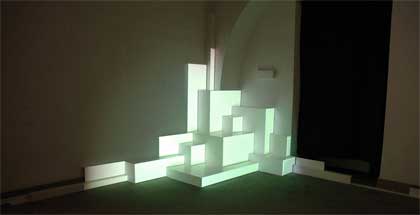
These ideas come to life in an abstract and geometric envelope, enhanced with synesthetic audio elements and establishing a dialogue with the observer.
I thought the piece called for some questions to Pablo Valbuena:
What is your background? Where do you come from?
I was born in Madrid, where I studied Architecture, after finishing my degree I was looking for some tangent fields related to architecture that were more experimental, so I started developing architecture for videogames, films, and digital architecture as a concept designer.
After some time working for several studios around the world I have recently started to focus on personal research working as an artist, although probably you can see a bit of everything related to my previous background in my present work.
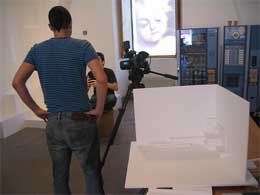 What was/were the biggest challenge(s) you encountered while working on this installation?
What was/were the biggest challenge(s) you encountered while working on this installation?
This piece was developed during the Interactivos? workshop at Medialab Madrid.I just had two weeks to produce it, that was for sure a big constraint, thanks to the help of some collaborators we managed to finish it.
Previously to the workshop I had a small scale model done where you could see how the idea was working. That solved most of the doubts I had of how the installation was going to be experienced.
The piece works overlapping two layers of space, a physical one and a
virtual one projected on top of the first. The small model was a bit difficult to adjust and scaling it up multiplied the problem and brought other issues, in the end the most difficult thing was adjusting the geometry (physical and virtual) of the two layers to make it fit. The optical aberration of projectors and the imperfections of dimensions made it difficult but finally I found some ways of solving it. It was definitely a key point to solve, because it is what gives life to the piece, the illusion that everything you see is part of the same physical object.
Can you tell us something about the way the installation works technically?
The installation is very low-tech in a way, which is something I really like about it. The most high tech device used is a projector, and in the actual technological race projection technology seems to be pretty old, it is something everyone is used to see.
I like this idea of not being on the edge technologically. It really seems that we have this hunger of producing new technologies for the sake of the new, not for what technology can do. The interesting part comes from the way you use the tool, or the ideas you want to speak about, not from the tool itself.
This is why I tried to keep it as simple as possible. We have been studying making the piece interactive to the observer. And this brought the argument of what kind of interaction should be. From my point of view, in this piece scale is going to be much more important in terms of interaction with the observer than any technological
trick you can play with. The way the observer is going to walk around the piece and discover it is going to produce much stronger impressions than any other reaction of the piece. Said that I may try other ways of interaction, but just in case it strengths the piece, not for the sake of it.
I would say that the interface with the observer should be more related to the idea of “promenade architecturale” from Le Corbusier than a more direct action/reaction sensor interface. For instance there is a huge difference of experiencing the installation live walking around it than watching it on video. This is the first piece of a line of work I am going to continue, the next step is going to be a bigger installation in a public urban space that I am currently prototyping and hopefully should be much stronger in terms of interaction through scale.
Thanks Pablo!

